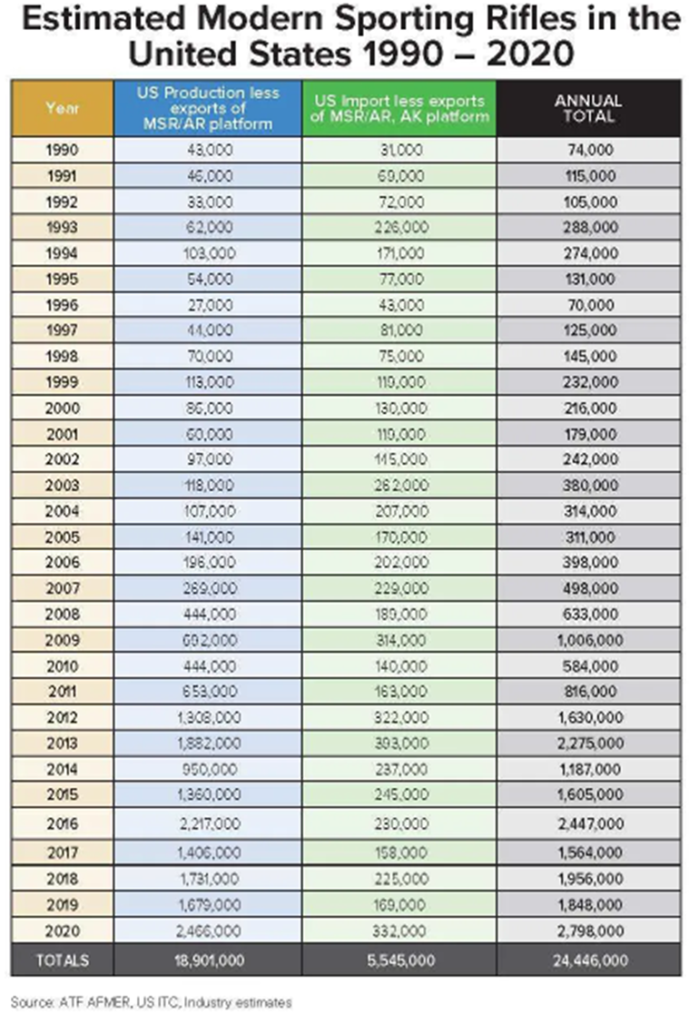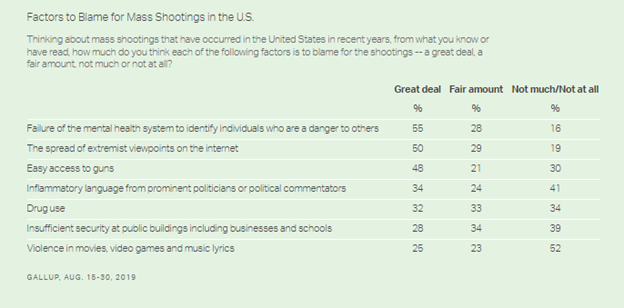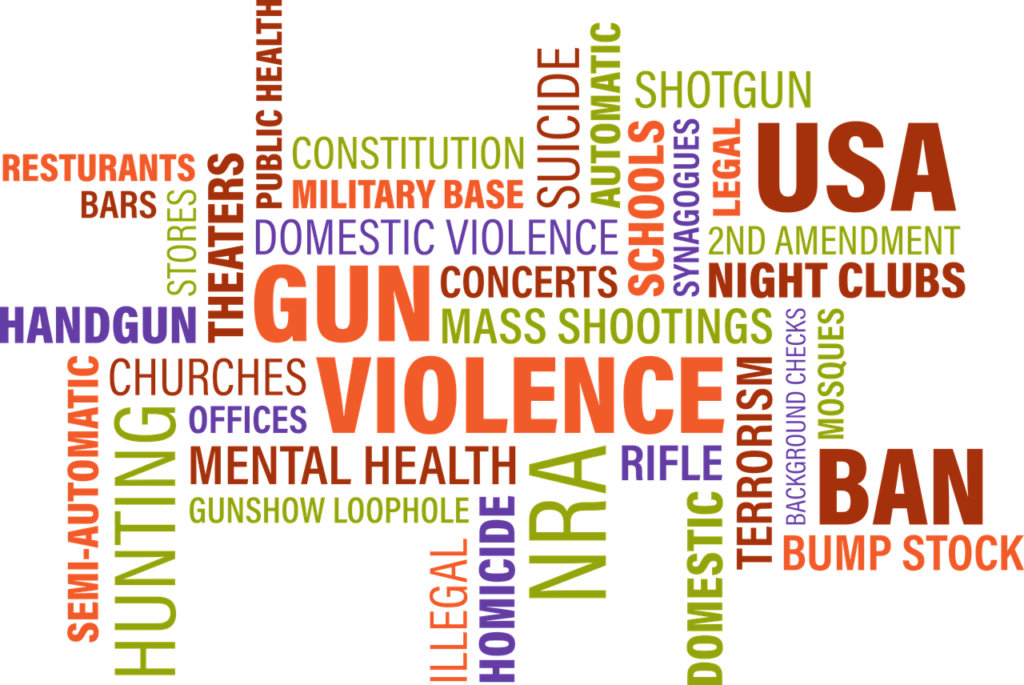In this third article of the series our focus is the alarming and tragic increase in mass shootings in the United States. Through research and analysis, we’ll identify the multiple reasons for this surge. While assault rifles and high-capacity magazines clearly have contributed to the increase, and while they are clearly part of the solution, the problem of mass shootings is much more multi-faceted. To halt the unconscionable horror, we’ll identify and explore the components of a multiple part solution.

Are Assault Rifles and High-Capacity Magazines Mostly to Blame?
The graph above depicts the alarming increase in mass shootings, especially since 2020. It’s almost impossible to comprehend that mass shootings are approaching an average of two a day. In the roughly ten days it takes me to draft, edit, and publish this 4-part series, there will be another 15-20 mass shootings. Other evidence demonstrates that these mass shootings are becoming more lethal in terms of deaths and injuries. Why is this happening?
The very high level of access to guns in America—particularly assault rifles and high-capacity magazines—is often cited as a reason for the increase in mass shootings and casualties. As of 2022, there are about 24.4 million AR-15-style rifles in the United States, according to the National Shooting Sports Foundation (NSSF), a trade association. NSSF reports year-to-year changes as to the number of such rifles in the graph below. As you’ll note, the NSSF no longer refers to these weapons as “assault style rifles”, and instead has dulcified them as “Modern Sporting Rifles” or “MSR’s.”

In the early 1990’s, before the federal ban on assault rifles, the number of assault rifles increased from 74,000 per year to 288,000 per year. During the 10-year ban (1994-2004), the number of new assault rifles put into circulation regularly averaged between 125,000 and 380,000 per year. Surprisingly, the 10-year ban failed to have much of an effect in limiting the production of assault rifles. After the end of the ban, the annual number of assault style rifles climbed more aggressively, especially after the election of President Barack Obama in 2008. Since 2012, the number of additional assault rifles (MSR’s) per year has been in the range of 1.5 to 2.8 million. In the latest decade (2011-2020), more than 18.1 million additional MSR’s have made it into the hands of Americans.
According to the NSSF, “The MSR remains the most-popular selling centerfire semiautomatic rifle in the United States today. There are more MSRs in circulation today than there are Ford F-Series trucks on the road. . . . This particular style of rifle is the top choice for law-abiding citizens for hunting, recreational shooting and self-defense.”
Mass shootings are also becoming more lethal, in terms of deaths and injuries, and the evidence implicates both assault rifles and “high-capacity magazines” for the carnage. As to assault rifles, Everytown for Gun Safety reports:
“Mass shooting incidents with four or more people killed where the shooter used an assault rifle resulted in an average of 2.4 times more people killed and 24 times more people wounded compared to incidents where the shooter did not use an assault rifle.”
As to high-capacity magazines Everytown reports:
“Of the 48 mass shootings with four or more people killed from 2015 to 2022 where the magazine type was known, incidents involving high-capacity magazines (HCMs) resulted in 2.5 times as many people killed and nearly 10 times as many total casualties as events with no HCMs.”
Furthermore, in the 10 deadliest US mass shootings, the weapon and magazine capacity were known in 9 of those instances. According to Everytown for Gun Safety, 8 of the 9 deadliest mass shootings involved an assault rifle and a high-capacity magazine.
Thus, the very widespread access to assault weapons and high-capacity magazines appear to be significant factors contributing to the increase in mass shootings, along with deaths, and injuries. But it would be a mistake to conclude that they are the only factors, or that banning assault weapons and high-capacity magazines would fix the problem.
What Other Factors Are At Play in Mass Shootings?
While assault rifles are very accessible, and, when combined with high-capacity magazines, very deadly, that’s not the end of our inquiry. Surprisingly, assault rifles are not the predominant weapon used in mass shootings: it’s handguns.
“Handguns are the most common weapon type used in mass shootings in the United States, with a total of 161 different handguns being used in 111 incidents between 1982 and April 2023. These figures are calculated from a total of 142 reported cases over this period, meaning handguns are involved in about 78 percent of mass shootings.”
Statista
Many of the handguns used in mass shootings had high-capacity magazines. Banning such magazines for handguns is thus an additional solution that must be considered.
Another major factor in mass shootings is the mental state of the perpetrator, as discussed in a study by the National Institute of Justice. Some 30% of mass shooters were suicidal prior to the shooting, and an additional 39% were suicidal during the shooting. Also, over 80% were in crisis. Despite suffering from these conditions, most shooters used legally obtained guns in the shootings (except for young school shooters who stole the guns from family members). These findings implicate background checks, waiting periods, and extreme risk laws. Shooters may have purchased the weapon in a situation where a background check was not required; or their mental health condition may not have been formally diagnosed. Also, they may have purchased the weapon in a state without red flag laws.
Another factor in mass shootings is that perpetrators have committed prior crimes (65.4% have a criminal record), and have a history of violence (62.8%), including domestic violence (27.9%).
Another factor that influences the increase in mass shootings, deaths, and injuries is the particular gun laws of each state. Studies have shown that states with more permissive gun laws—such as no or limited background checks, no restrictions on open carry, no red flag laws, or no restrictions regarding domestic violence—have higher rates of mass shootings. Conversely, states with strict gun laws have fewer mass shootings.
In summary, solving the problem of mass shootings will require action at both the federal and state levels, and involves much more than banning assault weapons and high-capacity magazines.
What Does the Public Think?
A 2019 Gallup survey addressed what the public thought about the reasons for the increase in mass shootings. Below is a summary of the factors to blame, going from highest to lowest:

Interestingly, we see some new factors emerging—at least in the eyes of the public. While most (83%) felt the mental health system was to blame, and easy access to guns also received a significant amount of blame (69%), the spread of extremist views on the internet was the second leading factor for blame (79%). Also, some 58% blamed inflammatory language from prominent politicians or political commentators.
Banning Assault Rifles: It’s Complicated
Ostensibly, a renewed federal ban on assault rifles appears to be an appropriate solution to ever-increasing gun violence, mass shootings, and casualties. Even though assault rifles aren’t a common denominator in mass shootings, they were the weapon of choice in the most-deadly incidents. Many argue that these “weapons of war” have no business in the hands of civilians because they are so lethal.
“The difference with high velocity bullets and military-grade weapons…is the damage they inflict on the human body and our internal organs are much more gruesome and tend to have what is known as a blast effect, because that bullet is carrying so much energy with it as it enters the human body . . . Instead of, for example, if the bullet traveled through the lung, instead of a hole in the lung, we’re looking at an exploded lung.”
Dr. Cornelia Griggs, pediatric and critical care surgeon at Massachusetts General Hospital
But banning assault rifles involves many complications that we shouldn’t ignore. First, if we go back in time, we’ll see that efforts to limit or ban assault rifles have actually created greater interest in owning such weapons. And we’ll also see that the gun industry and the NRA have been active in cultivating this interest.
When assault rifles were banned in 1994, the ban didn’t cover versions of these weapons unless they had two of these purely cosmetic features: a folding stock, a bayonet mount, a pistol grip, a flash suppressor, or a grenade launcher. Manufacturers quickly found a way to redesign around these constraints, and sales of assault rifles continued at previous levels, instead of decline. The ban was thus circumvented.
“With encouragement from the gun industry, the AR-15 grew popular not only among people who enjoyed owning the latest tactical gear, but also among recreational and competitive target shooters, and hunters. Many saw it as a pinnacle of firearms engineering — ergonomic, accurate, reliable.”
NBC News
With the election of Barack Obama, the fear of firearm controls created another surge in gun sales, including assault rifles. Again, firearm manufacturers, the NRA, and gun advocates seized upon the situation to lead record numbers of Americans to buy assault rifles. For example, in 2010, Bushmaster Firearms created a marketing campaign that linked assault rifle ownership with being manly. Here’s the visual:

A second complication regarding an assault weapons ban is that because of compromises necessary to get the legislation passed, the ban may be ineffective. The main problem is that the ban will probably not extend to assault weapons currently in circulation, but rather only as to purchases after the effective date of the legislation. Also, there will probably be a variety of exceptions. This was the case with the original assault weapons ban of 1994; and it was the case with the assault weapons ban passed by the Democrat-controlled House of Representatives in 2022. Given that there are already more than 24 million assault rifles in circulation the dilemma is clear: an absolute ban would require these millions of guns to be taken away from mostly law-abiding owners; yet leaving these guns in circulation creates huge opportunities for them to fall into the wrong hands.
A third complication is that an assault rifle ban may be declared unconstitutional. The US Supreme Court has previously upheld assault weapon bans on the basis that they are “dangerous and unusual weapons” as opposed to guns “in common use” at the time. However, those decisions were before assault rifles had become so numerous; and more important, the current Court is far more conservative than the Courts that issued the prior opinions. The current Court has supported a broad reading of the 2nd Amendment. Also, in June of 2022, it sent back a challenge to a lower court’s ruling that upheld Maryland’s assault weapons ban. Conservative legal experts are arguing the Supreme Court will overturn assault rifle bans adopted by various states.
A fourth complication is the split of opinion over whether assault rifle bans are effective. The NRA, the gun industry, and gun rights advocates have produced studies and arguments that the 1994 ban did not work and had no impact on crime. A Rand Corporation study found that the evidence for the effect of assault weapons ban on mass shootings was inconclusive. On the other hand, a 2019 study of open-source data reported in the National Institute of Health found mass-shooting related homicides were reduced by 70% during the years of the federal assault weapons ban. Given that the 1994 ban only related to new purchases (current owners kept their rifles), and given that exceptions and loopholes allowed hundreds of thousands of new assault rifles to be put into circulation each year, the success of the ban was undermined from the start.
Where Do We Go From Here?
Given the 2nd Amendment and the very high level of access to guns in America, we have a dilemma. We have 81 million Americans who possess hundreds of millions of guns, including more than 24 million assault rifles. The vast majority of gun owners are law-abiding and do not present a danger to themselves or others. On the other hand, we have seen that mass shootings are predominantly committed by people who are suicidal or in crisis. Also, the highest casualty mass shootings have almost always involved assault rifles and high-capacity magazines. The needle we have to thread is to get the guns (especially assault rifles and high-capacity magazines) out of the hands of people who present a danger to themselves or others while respecting the rights of law- abiding gun owners to the maximum extent possible.
While we’ll talk more about solutions in the final article, here are some initial thoughts about a multi-pronged approach to prevent mass shootings and reduce the carnage.
Address loopholes and weaknesses in the federal background checks system.
There are too many ways to acquire a firearm without a background check. Also, the lack of timely reporting of information required in background checks allows too many prohibited purchasers to acquire guns because of incomplete records. Finally, more crimes with convictions should prohibit ownership (e.g., individuals with domestic abuse or stalking convictions). Universal background checks with more information, broader prohibitions, and possibly longer waiting periods will, however, impose a burden on all purchasers in order to keep guns out of the hands of prohibited purchasers.
More states should pass extreme risk laws (red flag laws).
People who present a danger to themselves or others often tip off this behavior to family members, friends, or others. FBI studies of pre-attack behavior have identified four to five observable and concerning behaviors over time. Nearly half of individuals who engaged in mass shootings (48%) leaked their plans in advance to others, including family members, friends, and colleagues, as well as strangers and law enforcement officers. Extreme risk laws can empower those who know an individual in crisis to petition a court for an order temporarily restricting their access to weapons. The Bipartisan Safer Communities Act passed by Congress in 2022 provides incentives for states to enact such laws.
High-capacity magazines should be banned either by federal law, or more states.
Such magazines have caused mass shootings to be more lethal in terms of deaths and injuries. Given that it will be impossible to prevent all assault rifles and handguns from falling into the wrong hands, limiting the lethality of the weapon seems justified, even if it means that all law-abiding gun owners must abide by such restrictions. However, the odds of passing such a law at the federal level are very limited. Currently, ten states have enacted limits, and most are being challenged under the 2nd Amendment. The Supreme Court has yet to rule on the matter.
Address the spread of extremist viewpoints.
We need to consider solutions to address the spread of extremist viewpoints, especially over the internet, and we should also include inflammatory language from politicians and political commentators. It’s clear that some mass shooters have been radicalized by social media. It’s also clear that mass shooters resort to the internet for validation. Solutions will be limited and complicated because of the First Amendment rights of those posting such language and viewpoints. But when extremist viewpoints or inflammatory language can be shown to have caused a person to commit crime, there should be a remedy. Also, while social media companies currently cannot be held liable for content published by users of their platforms (“Section 230”), this matter is under debate in Congress, and other countries have acted to assure social media companies take more responsibility regarding content published by users.
Attempt to regulate – not necessarily ban – assault rifles.
Finally, banning the production of new assault rifles, or banning all assault rifles are solutions that come with complications. We should assess whether a ban on new sales alone would be effective. Also, if the ban were to extend to all existing assault rifles, this would entail taking away some 24 million firearms, the vast majority of which are owned by citizens who are law-abiding. Finally, there is a real possibility that the U.S. Supreme Court will preclude this solution.
Instead of banning assault rifles, an alternative solution might be to regulate them. The Supreme Court has recognized that the 2nd Amendment is, “not a right to keep and carry any weapon whatsoever in any manner whatsoever and for whatever purpose.” At one end of the spectrum machine guns have been prohibited, and at the other end of the spectrum we have weapons like a 22-caliber single shot rifle. It stands to reason that not all firearms need to be treated equally, and that some could be more regulated than others, instead of being prohibited. Perhaps those who wish to own and keep an assault rifle should be subject to a higher level of scrutiny or control than those who purchase less lethal and dangerous weapons. While assault rifles might remain fully legal in the home, at the range, and for hunting, perhaps there might be some regulations on open or concealed carry, or in public places. In essence, because these weapons are exceptionally deadly, and because they have been used in deadly mass shootings, our legislatures should have the authority to impose reasonable restrictions that protect the health and safety of the public.
Again, these are thoughts, not recommendations. In the final article we’ll attempt to come up with a comprehensive set of common ground solutions.
Next in the Series
EXPLORE THE WHOLE SERIES
Gun Violence in America

As Gun Violence and Mass Shootings Surge, Partisan Politics Has Failed Us on Solutions (Part 1 of 4)

Gun Violence: What Can Research Teach Us? (Part 2 of 4)

Why Have Mass Shootings Surged and How Do We Stop the Carnage? (Part 3 of 4)

Leave a Reply